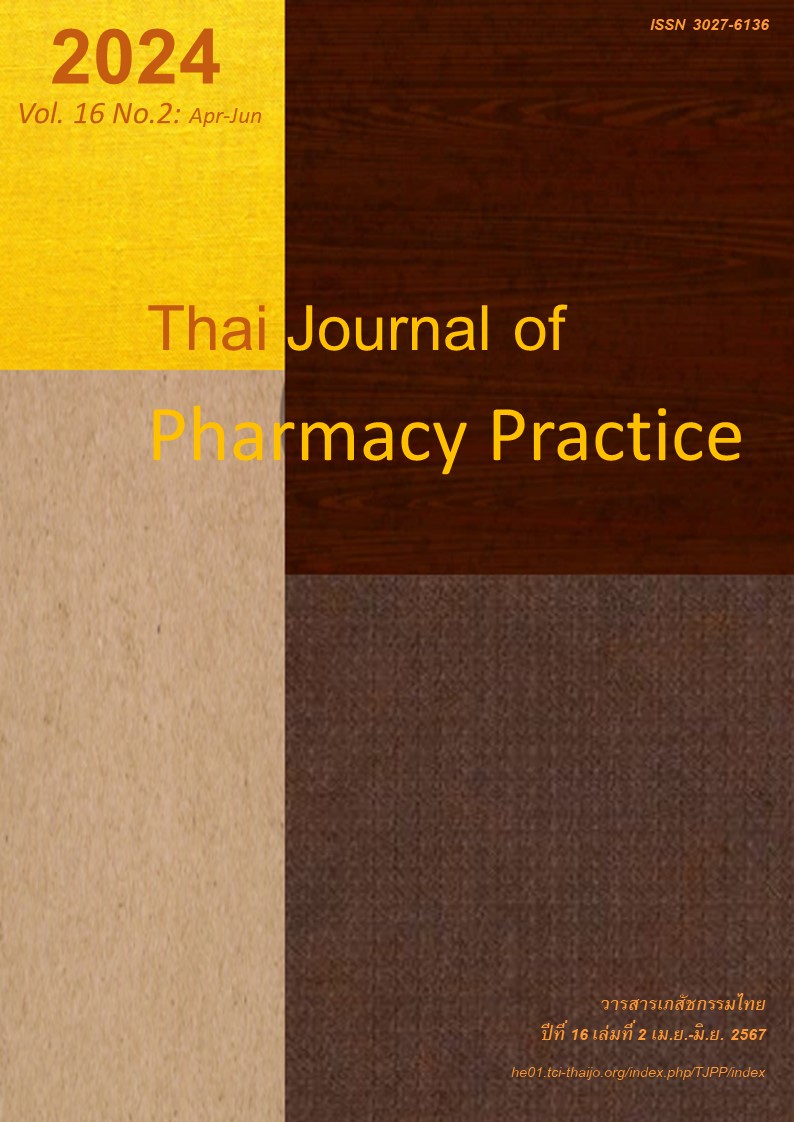ผลของการบริบาลทางเภสัชกรรมในผู้ป่วยวัณโรคปอดที่ไม่ให้ความร่วมมือในการใช้ยาระหว่างการรักษาในระยะเข้มข้น
Main Article Content
บทคัดย่อ
วัตถุประสงค์: เปรียบเทียบผลก่อนและหลังการบริบาลทางเภสัชกรรมในผู้ป่วยวัณโรคปอดที่ไม่ให้ความร่วมมือในการใช้ยาในระหว่างการรักษาในระยะเข้มข้น วิธีการ: การศึกษาแบบกึ่งทดลองในผู้ป่วยวัณโรคปอดที่ไม่ให้ความร่วมมือในการใช้ยาในการรักษาระยะเข้มข้นครั้งนี้ ทำในโรงพยาบาลบ้านไผ่ จังหวัดขอนแก่น ระหว่าง เดือนมิถุนายน พ.ศ. 2564 ถึง เดือน กุมภาพันธ์ พ.ศ. 2565 การศึกษาคัดเลือกผู้ป่วยที่ไม่ให้ความร่วมมือในการใช้ยาเข้าการศึกษาโดยวิธีนับเม็ดยาที่เหลือหลังจากผู้ป่วยรับประทานยา 14 วัน การแทรกแซง คือ การให้บริบาลทางเภสัชกรรมแบบปกติในโรงพยาบาล 3 ครั้ง คือ ในวันที่ 14, 28 และ 56 หลังเริ่มรับประทานยาและการลงเยี่ยมบ้านโดยเภสัชกร 1 ครั้ง ในวันที่ 21 หลังเริ่มรับประทานยา การเยี่ยมบ้านใช้เครื่องมือ INHOMESS สอนการ DOT (direct observe treatment) แก่ผู้ดูแล ร่วมกับค้นหาและแก้ไข DRPs และให้ความรู้ด้านยาแก่ผู้ป่วยและผู้ดูแล ผลการวิจัย: ผู้ป่วยวัณโรคปอดจำนวน 117 รายหลังได้รับยานาน 14 วันพบว่ามีผู้ที่ไม่ให้ความไม่ร่วมมือในการใช้ยา 40 ราย (ร้อยละ 34.19) และถูกเชิญเข้าร่วมการศึกษาทุกราย การประเมินผลในวันที่ 28 และ 56 หลังการแทรกแซงพบว่า มีผู้ไม่ร่วมมือในการใช้ยาเหลือ 2 รายและ 1 ราย ตามลำดับ การเยี่ยมบ้านในวันที่ 21 หลังเริ่มรับประทานยาพบ DRPs 11 ครั้งในผู้ป่วย 11 คน ปัญหาที่พบมากที่สุด คือ การเลือกใช้ยาที่ไม่เหมาะสม (5 ครั้ง) เช่น ผู้ป่วยกินยาชง ยาสมุนไพรแก้ปวด หรือยาแคปซูลจากร้านชำ การกินใบกัญชาต้ม การแก้ไขทำโดยจัดการที่ตัวผู้ป่วยมากที่สุด (7 จากทั้งหมด 11 ปัญหา) โดยการปรับทัศนคติในการรักษา ผู้ป่วยมีคะแนนความรู้เรื่องโรคการปฏิบัติตัวและการใช้ยาก่อนให้ความรู้ในวันที่ 14 และหลังการเยี่ยมบ้านในวันที่ 28 เฉลี่ย 9.68±2.17 และ 13.05 ± 1.20 คะแนน ตามลำดับ (P<0.001) เมื่อสิ้นสุดระยะเข้มข้น ผลการตรวจพบเชื้อในเสมหะและเอ็กซเรย์ปอดพบเชื้อในเสมหะทั้งหมด 2 ราย และมีร่องรอยโรคที่ปอด จำนวน 3 ราย คนในครอบครัวช่วยกำกับดูแลการรับประทานยาเพิ่มจาก 22 รายก่อนการบริบาลทางเภสัชกรรมเป็น 35 รายหลังการบริบาลทางเภสัชกรรม สรุป: การบริบาลทางเภสัชกรรมแบบปกติร่วมกับการเยี่ยมบ้านมีประสิทธิภาพที่ดีในการเพิ่มความร่วมมือในการใช้ยาต้านวัณโรคในระยะเข้มข้นของการรักษา
Article Details

อนุญาตภายใต้เงื่อนไข Creative Commons Attribution-NonCommercial-NoDerivatives 4.0 International License.
ผลการวิจัยและความคิดเห็นที่ปรากฏในบทความถือเป็นความคิดเห็นและอยู่ในความรับผิดชอบของผู้นิพนธ์ มิใช่ความเห็นหรือความรับผิดชอบของกองบรรณาธิการ หรือคณะเภสัชศาสตร์ มหาวิทยาลัยสงขลานครินทร์ ทั้งนี้ไม่รวมความผิดพลาดอันเกิดจากการพิมพ์ บทความที่ได้รับการเผยแพร่โดยวารสารเภสัชกรรมไทยถือเป็นสิทธิ์ของวารสารฯ
เอกสารอ้างอิง
World Health Organization. Global tuberculosis report 2018. Geneva, Switzerland: World Health Organi- zation Stop TB Department; 2018.
Ministry of Public Health. National Tuberculosis Control Programme Guideline in Thailand 2021. Bangkok: Bureau of Tuberculosis; 2021
Strategy and Planning Division, Office of Permanent Secretary, Ministry of Public Health 2018.National tuberculosis strategy planning 2017-2021. Nonthaburi: Strategy and Planning Division; 2018.
The Seventh Region National Health Security Office at Khon Kaen. A handbook of developing primary care system in fiscal Year 2014. Khon Kaen: The Seventh Region National Health Security Office at Khon Kaen; 2014.
Ningsanon T, Monthakamkul P, Wanakmanee U, Suansanea T, Chatuporn T. Textbook of family pharmacist. Bangkok: Association of Hospital Pharmacy (Thailand); 2014.
Hanrinth R. Classification for drug related problem. Thai Journal of Pharmacy Practice 2009; 1: 90-2.
World Health Organization. Adherence to long-term therapies: Evidence for action. Geneva, Switzerland: WHO; 2003.
Pitisuttithum P, Pichaensoonthon C. Textbook of clinical research. Bangkok: Vaccine trial center Mahidol University; 2018.
Sarasalin R, Kitsripisan S, Ratchanagul. Effects of promoting adherence to a treatment regimen on the intention and adherence behaviors among pulmo- nary tuberculosis patients. Nursing Journal 2013; 40: 166-8.
Khamduang N, Pongpattanawut S. Outcomes of pharmaceutical care in patients with pulmonary tuber culosis at Somdejprasangkharach XVII Hospital, Suphanburi. Thai journal of Pharmacy Practice 2017; 10: 346-53.
Jitdon J, Durongrittchai V, Khungtumneam K. The Development of guidelines on home visiting pulmo- nary tuberculosis patients with short course treat- ment in Mueang District, Samut Prakan Province. HCU Journal of Health Science 2017; 20: 3-11.
Vernon A, Fielding K, Savic R, Dodd L, Nahid. The importance of adherence in tuberculosis treatment clinical trials and its relevance in explanatory and pragmatic trials. PLoS Med 2019; 16: e1002884. doi: 10.1371/journal.pmed.1002884.
Chaovakiratipong C. Result of home visit among sputum-positive tuberculosis patients Mae Sot Municipality, Tak Province, 2002-2006. Sawanpra charak Medical Journal 2008; 5: 757-67.
Ministry of Public Health. National tuberculosis control programme guideline Thailand 2018. Bang- kok : Bureau of Tuberculosis; 2018.
Mekonnen HS, Azagew AW. Non-adherence to anti-tuberculosis treatment, reasons and associated factors among TB patients attending at Gondar town health centers, Northwest Ethiopia. BMC Res Notes. 2018; 11: 691. doi: 10.1186/s13104-018-3789-4.
Julawonno N. Effects of an individual education program on self-care behavior among patients with tuberculosis. The Southern College Network Journal of Nursing and Public Health 2016; 3: 17-30.
Radchaniyom S, Saramunee K. Family pharmacist’s management of drug related problem for chronic diseases at patient’s in home, Kranuan Dristrict Health Network. Thai Journal of Pharmacy Practice 2016; 8: 169-81.
Muangsri P, Durongritichai V, Kompayak J, Tangsu jaritvijit V. The effectiveness of home visit under- pinned By Orem’s nursing theory for enhancing self–care capabilities of pulmonary tuberculosis patients who are sputum smear-positive. HCU Journal of Health Science 2012; 16: 31-46.
Jitdon J. The community nurse practitioner role to promote the care of tuberculosis patients at home, with an emphasis on family – centered care. HCU Journal of Health Science 2018; 22: 180-92.
Suwankeeree W, Picheansathien W. Strategies to promote adherence to treatment by pulmonary tuberculosis patient: a systemic review. JBI Libr Syst Rev 2012; 10: 615-78.
Chayanattapong P. Drug related problem in patients with chronic disease during home visit by pharmacist in the family care team of Promkiri District Health Network. Thai Journal of Pharmacy Practice 2017; 9: 103-10.
Thomudtha P, Pattanajak C, Khampa S, Phoomwanitchakit S, Jeeraaumponwat P, Plerin P. Effects of home care pharmacy service in urban area health system, Mahasarakham Province. Srinagarind Medi- cal Journal 2017; 32: 229-32.


